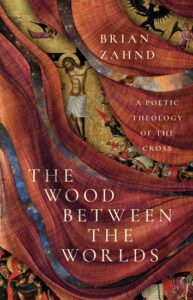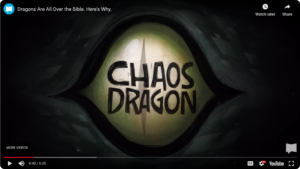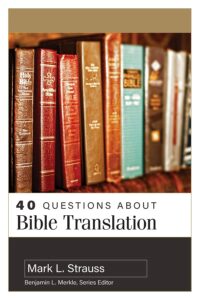My brother-in-law was fond of saying with a wry grin, “Wives are supposed to submit with joy, and husbands are supposed to . . . er, are supposed to . . . um, I always forget that part!”
Many have tripped over what the apostle Paul says in his infamous passage about marriage. That’s the one in his letter to the Ephesians where he talks about submission. What he actually says, though, may surprise some–including my brother-in-law.
 First, Paul introduces this section on husbands and wives with, “Submit to one another out of reverence for Christ.” Submission for Paul is mutual, not just something a wife offers her husband.
First, Paul introduces this section on husbands and wives with, “Submit to one another out of reverence for Christ.” Submission for Paul is mutual, not just something a wife offers her husband.
This is consistent with his whole letter which tells us that unity, oneness in Christ, summarizes the whole purpose and aims of God (Eph 1:9-10). One particular example of this is the unity that different groups of people, Jews and Gentiles in this case, were to have in Christ (Eph 2:14; 3:6). In fact such oneness is the key evidence for the principalities and powers that they are no longer in charge but that God is instead (Eph 3:10-11).
The next three chapters are about how this unity is to be maintained (Eph 4:2-3). Humility, gentleness, patience, and love are to characterize how all Christians relate to all other Christians. Pride, harshness, and domination are not how Jews and Gentiles, or men and women, should relate to each other.
Second, when it comes to Paul’s specific instructions, note that he addresses wives and husbands separately (Eph 5:22-24 and 25-33). What’s the significance of this? For one, Paul never says, “Husbands, make sure your wives submit!” The instruction is to wives, not husbands. It’s an issue between a wife and her Lord. Husbands need to leave Ephesians 5:22-24 to their wives and not use it as a weapon in their relationship. The same is true for wives regarding 5:25-33.
Third, Paul devotes three verse to wives but nine verse to husbands—three times as much. Why? In the typically patriarchal culture of Paul’s day, what he says to wives may not sound that new except for the key point he emphasizes—the motivation and means for being a wife is centered on Christ.
Everything Paul says to husbands, however, is very different from what they would have heard from their society. So Paul needs extra time to impress these differences on them. And what does Paul say?
He says husbands are to love their wives “just as Christ loved the church and gave himself up for her.” Husbands are to die—like Jesus. Christ sacrificed his life, set aside his status and authority, so the church could flourish in holiness and union with God (Eph 5:25-27). The main job of a husband is not to rule, not to command, not to decide, but to die. If his career goals get in the way of the good of his wife, his ambitions must die. If the part of the country he wants to live in gets in the way of his wife flourishing in Christ, that must die.
 Years ago my wife Phyllis felt stunted in her spiritual life by the church we were in. I took that seriously, even though I liked the church. I liked the people. I liked the music. I liked the preaching. It was great for me. After many months of discussion and prayer, however, we were not able to resolve the issue. Then I remembered that Ephesians 5 meant that my wife’s spiritual well-being came before mine. I had to die. So I told her, “It’s up to you. If you want us to go to a different church, we will. I want what’s best for you.”
Years ago my wife Phyllis felt stunted in her spiritual life by the church we were in. I took that seriously, even though I liked the church. I liked the people. I liked the music. I liked the preaching. It was great for me. After many months of discussion and prayer, however, we were not able to resolve the issue. Then I remembered that Ephesians 5 meant that my wife’s spiritual well-being came before mine. I had to die. So I told her, “It’s up to you. If you want us to go to a different church, we will. I want what’s best for you.”
The primary job of a husband is not to make sure his wife stays in her lane. Rather, if she has gifts in hospitality, generosity, leadership, evangelism, compassion, teaching, getting people organized, or more, my role is to support, encourage, and pave the way for her. After all, as Genesis 1:28 says, God’s design for men and women is to rule the created order together as God’s representatives.
My parents had a tremendously positive influence on me by modeling a marriage of true partnership. But throughout the five decades of my own marriage, Ephesians 5 had more. My love for Phyllis focused me on making sure she had every opportunity to grow closer to God and use all the many gifts God gave her.
Now if you are very good and very quiet and if you listen very carefully, in my next time installment I will tell you a story full of twists and turns, pathos and poetry (not to mention uproarious surprises) in which Andy tries to do something good for Phyllis, and she just won’t cooperate.
—
Image: Wedding rings by Arek Socha from Pixabay
Image: Church from Immanuel Presbyterian Church, Warrenville, IL.
 In fact, when the King James Version was originally typeset and published, each verse began its own paragraph. And that is still the way it is printed!
In fact, when the King James Version was originally typeset and published, each verse began its own paragraph. And that is still the way it is printed!


 Because the New Testament writers were people steeped in the Old Testament, that’s where they often drew ideas, motifs, and references to understand this surprising Jesus who was not the military Messiah they expected. The language of “passing by” recalls the story in Exodus 32–33 when Moses asked God to see his glory. God says, “When my glory passes by, I will put you in a cleft in the rock and cover you with my hand until I have passed by” (Exodus 33:22, my emphasis).
Because the New Testament writers were people steeped in the Old Testament, that’s where they often drew ideas, motifs, and references to understand this surprising Jesus who was not the military Messiah they expected. The language of “passing by” recalls the story in Exodus 32–33 when Moses asked God to see his glory. God says, “When my glory passes by, I will put you in a cleft in the rock and cover you with my hand until I have passed by” (Exodus 33:22, my emphasis).
 First, Paul introduces this section on husbands and wives with, “Submit to one another out of reverence for Christ.” Submission for Paul is mutual, not just something a wife offers her husband.
First, Paul introduces this section on husbands and wives with, “Submit to one another out of reverence for Christ.” Submission for Paul is mutual, not just something a wife offers her husband.  Years ago my wife Phyllis felt stunted in her spiritual life by the church we were in. I took that seriously, even though I liked the church. I liked the people. I liked the music. I liked the preaching. It was great for me. After many months of discussion and prayer, however, we were not able to resolve the issue. Then I remembered that Ephesians 5 meant that my wife’s spiritual well-being came before mine. I had to die. So I told her, “It’s up to you. If you want us to go to a different church, we will. I want what’s best for you.”
Years ago my wife Phyllis felt stunted in her spiritual life by the church we were in. I took that seriously, even though I liked the church. I liked the people. I liked the music. I liked the preaching. It was great for me. After many months of discussion and prayer, however, we were not able to resolve the issue. Then I remembered that Ephesians 5 meant that my wife’s spiritual well-being came before mine. I had to die. So I told her, “It’s up to you. If you want us to go to a different church, we will. I want what’s best for you.” Take what Paul says in his letter to the Galatians, for example. It’s a well-known verse often referenced in these discussions. “There is neither Jew nor Gentile, neither slave nor free, nor is there male and female, for you are all one in Christ Jesus” (Gal 3:28). This comes in the middle of a letter that is about making sure Gentiles are treated as full members in the body of Christ, not as second-class Christians. Law shouldn’t divide us, Paul says. Rather grace should unite us.
Take what Paul says in his letter to the Galatians, for example. It’s a well-known verse often referenced in these discussions. “There is neither Jew nor Gentile, neither slave nor free, nor is there male and female, for you are all one in Christ Jesus” (Gal 3:28). This comes in the middle of a letter that is about making sure Gentiles are treated as full members in the body of Christ, not as second-class Christians. Law shouldn’t divide us, Paul says. Rather grace should unite us. Paul’s passionate argument in Galatians calls on all of us to seriously ask questions such as, “How can we all proactively do more? What can we do to make sure that the women in our congregation are growing in Christ, learning more of his grace, growing in their love for God and others? Are there practical changes we can implement that will aid and encourage all groups (but especially those who may be sidelined, because that is Paul’s point) to more fully use their gifts for the building up of the body of Christ? How can we make sure the talents, experiences, and opinions of women are appreciated, that their dignity as people in the image of Christ is affirmed? In this context, how can we look to the interests of others first rather than our own (Phil 2:3-4)?”
Paul’s passionate argument in Galatians calls on all of us to seriously ask questions such as, “How can we all proactively do more? What can we do to make sure that the women in our congregation are growing in Christ, learning more of his grace, growing in their love for God and others? Are there practical changes we can implement that will aid and encourage all groups (but especially those who may be sidelined, because that is Paul’s point) to more fully use their gifts for the building up of the body of Christ? How can we make sure the talents, experiences, and opinions of women are appreciated, that their dignity as people in the image of Christ is affirmed? In this context, how can we look to the interests of others first rather than our own (Phil 2:3-4)?”
 Chaos dragons are a common image in ancient near eastern literature, and the Bible writers take this and give it several twists for their own purposes. Such dragons often threaten humanity and the whole order God has created. They are associated with the disorder of the sea especially (see my
Chaos dragons are a common image in ancient near eastern literature, and the Bible writers take this and give it several twists for their own purposes. Such dragons often threaten humanity and the whole order God has created. They are associated with the disorder of the sea especially (see my 
 While the differences in Bible versions can be confusing, it’s important to remember the advantages. It means we have a variety of translations well suited for different purposes–some for public reading, some for study, and others for devotional reading. In addition, if we come across phrases like “holy kiss,” “with . . . a double heart,” “make their ears heavy”—we may be left a bit befuddled. By comparing different translations, we can sometimes get a better sense of the range of meanings in a text. 40 Questions charts dozens of translations along a continuum to show how they each wrestle with the balance of accuracy and readability in different ways.
While the differences in Bible versions can be confusing, it’s important to remember the advantages. It means we have a variety of translations well suited for different purposes–some for public reading, some for study, and others for devotional reading. In addition, if we come across phrases like “holy kiss,” “with . . . a double heart,” “make their ears heavy”—we may be left a bit befuddled. By comparing different translations, we can sometimes get a better sense of the range of meanings in a text. 40 Questions charts dozens of translations along a continuum to show how they each wrestle with the balance of accuracy and readability in different ways.